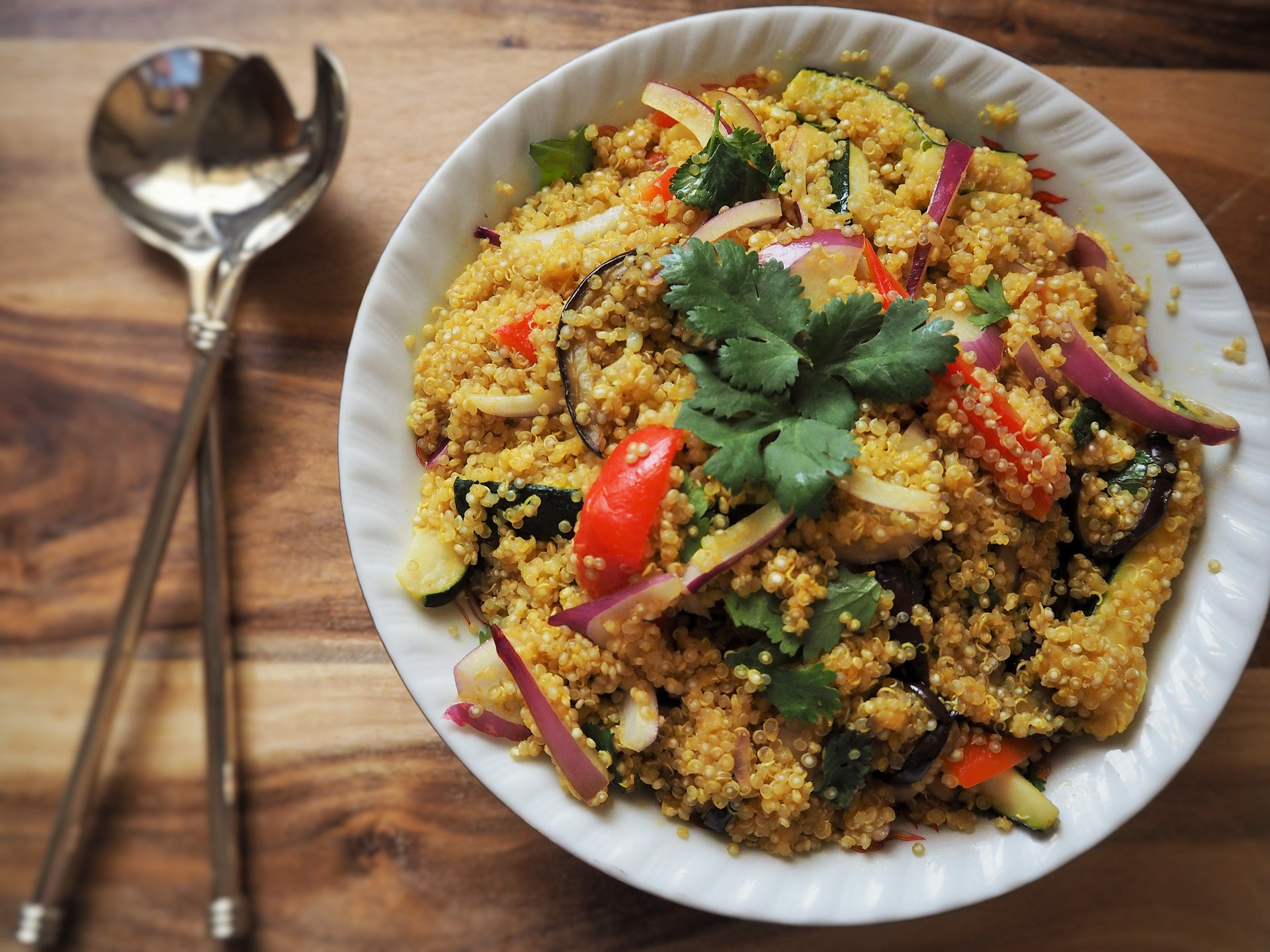Is This The New Quinoa? Exploring The Latest Health Food Trend

Table of Contents
Top Contenders for the "New Quinoa" Title
Several grains are stepping up to challenge quinoa's dominance in the superfood arena. Let's explore three prominent contenders: teff, amaranth, and freekeh.
! ! !
Teff: The Tiny Grain with Giant Nutritional Power
This tiny grain, originating in Ethiopia, packs a powerful nutritional punch.
- High in protein, iron, and fiber: Teff provides a significant boost to your daily intake of essential nutrients, supporting muscle growth, energy levels, and digestive health. It's a particularly good source of iron, crucial for preventing anemia.
- Gluten-free: Teff is a safe and nutritious option for individuals following a gluten-free diet, offering a delicious and versatile alternative to wheat-based products.
- Versatile in cooking (porridge, bread, etc.): From fluffy porridge to hearty breads and even pancakes, teff's versatility makes it a staple in diverse cuisines. Its slightly nutty flavor lends itself well to both sweet and savory dishes.
- Sustainable crop: Teff is known for its drought resistance and adaptability, making it a sustainable and environmentally friendly choice. Its cultivation requires less water than many other grains.
- Growing popularity in health-conscious diets: Teff's nutritional profile and sustainable nature are driving its increasing popularity among health-conscious consumers seeking nutritious and ethical dietary choices.
Compared to quinoa, teff boasts a higher concentration of iron and calcium, making it an excellent choice for those needing to increase their intake of these essential minerals. However, quinoa offers a slightly higher protein content.
Amaranth: Ancient Grain, Modern Superfood
Amaranth, an ancient grain cultivated for thousands of years, is experiencing a modern resurgence as a superfood.
- Complete protein source: Amaranth is a complete protein, meaning it contains all nine essential amino acids, making it a valuable addition to vegetarian and vegan diets.
- Rich in antioxidants: Its impressive antioxidant content helps protect your cells from damage caused by free radicals, contributing to overall health and well-being.
- Gluten-free: Like teff, amaranth is naturally gluten-free, making it suitable for individuals with celiac disease or gluten sensitivity.
- Pleasant nutty flavor: Amaranth possesses a mild, nutty flavor that complements various dishes. It can be enjoyed popped like popcorn, cooked as a porridge, or incorporated into salads and baked goods.
- Used in various dishes (salads, side dishes, etc.): Its versatility makes it a welcome addition to countless recipes, adding both nutritional value and a unique texture.
- History and cultural significance: Amaranth holds significant cultural and historical importance in various indigenous cultures, representing a link to ancient traditions and sustainable food systems.
While quinoa and amaranth share a similar protein content, amaranth stands out with its higher concentration of antioxidants, contributing to its strong anti-inflammatory properties.
Freekeh: The Smoky, Roasted Wheat Berry
Freekeh, a young green wheat grain roasted before harvesting, offers a unique culinary experience.
- High in fiber: Freekeh's high fiber content promotes digestive health, regulates blood sugar levels, and contributes to feelings of fullness.
- Rich in minerals: This grain is a good source of various minerals, including magnesium, zinc, and manganese, essential for numerous bodily functions.
- Unique smoky flavor: The roasting process imparts a distinct smoky flavor, adding a depth of taste to various dishes.
- Versatile in salads, bowls, and as a side dish: Freekeh's robust flavor and chewy texture make it a perfect addition to salads, grain bowls, and as a flavorful side dish.
- Environmental benefits compared to traditional wheat: The early harvesting of freekeh reduces water consumption and the need for pesticides compared to traditional wheat cultivation.
Freekeh’s nutritional profile is comparable to quinoa in terms of fiber content, but its smoky flavor profile offers a unique culinary advantage. It also generally boasts a lower glycemic index than quinoa.
Comparing Nutritional Profiles: Quinoa vs. The Contenders
| Nutrient | Quinoa | Teff | Amaranth | Freekeh |
|---|---|---|---|---|
| Protein (g/100g) | ~14 | ~14 | ~14 | ~12 |
| Fiber (g/100g) | ~3 | ~10 | ~10 | ~14 |
| Iron (mg/100g) | ~2.8 | ~8 | ~7 | ~2 |
This table highlights the key nutritional differences. While quinoa provides a good balance of nutrients, teff excels in iron, amaranth in antioxidants, and freekeh in fiber. The glycemic index (GI) varies; quinoa has a moderate GI, while freekeh generally has a lower GI, beneficial for blood sugar control.
Culinary Applications and Versatility
Each "new quinoa" contender shines in various culinary applications:
- Teff: Use it in porridge, injera (Ethiopian flatbread), bread, or even as a flour substitute in baking.
- Amaranth: Pop it like popcorn, cook it as a porridge or side dish, or incorporate it into salads and pilafs. Its slightly nutty flavor pairs well with both sweet and savory ingredients. Recipe ideas abound online!
- Freekeh: Add it to salads for a textural and flavorful boost. It's also delicious in grain bowls, as a hearty side dish, or in soups.
Environmental Impact and Sustainability
Teff, amaranth, and freekeh generally exhibit higher levels of environmental sustainability than quinoa in certain aspects: Teff's drought resistance reduces water needs; amaranth often requires fewer pesticides; and freekeh's early harvesting reduces environmental impact compared to conventional wheat. However, specific environmental impacts vary based on farming practices and location.
Conclusion
While quinoa remains a nutritional powerhouse, exploring alternatives like teff, amaranth, and freekeh expands your healthy eating options and contributes to dietary diversity. These "new quinoa" options offer unique nutritional benefits, culinary versatility, and often boast enhanced sustainability. Try incorporating these exciting new foods into your diet and discover the delicious and nutritious possibilities! Start experimenting with these exciting new foods today and find your new favorite healthy grain!

Featured Posts
-
 How Trumps Presidency Will Impact Mark Zuckerberg And Meta
Apr 29, 2025
How Trumps Presidency Will Impact Mark Zuckerberg And Meta
Apr 29, 2025 -
 Georgian Husband Arrested Wife Seriously Injured In Germany Arson Case
Apr 29, 2025
Georgian Husband Arrested Wife Seriously Injured In Germany Arson Case
Apr 29, 2025 -
 Falling Retail Sales Signal Potential Bank Of Canada Rate Cuts
Apr 29, 2025
Falling Retail Sales Signal Potential Bank Of Canada Rate Cuts
Apr 29, 2025 -
 Metas Future Under The Shadow Of The Trump Administration
Apr 29, 2025
Metas Future Under The Shadow Of The Trump Administration
Apr 29, 2025 -
 Minnesota Twins Win Over New York Mets 6 3
Apr 29, 2025
Minnesota Twins Win Over New York Mets 6 3
Apr 29, 2025
Latest Posts
-
 New Music Willie Nelsons Oh What A Beautiful World Album Details
Apr 29, 2025
New Music Willie Nelsons Oh What A Beautiful World Album Details
Apr 29, 2025 -
 Willie Nelson Documentary Leading Austin News Story
Apr 29, 2025
Willie Nelson Documentary Leading Austin News Story
Apr 29, 2025 -
 Quick Facts About Willie Nelson Life Career And Legacy
Apr 29, 2025
Quick Facts About Willie Nelson Life Career And Legacy
Apr 29, 2025 -
 Willie Nelson Announces New Album Oh What A Beautiful World
Apr 29, 2025
Willie Nelson Announces New Album Oh What A Beautiful World
Apr 29, 2025 -
 Willie Nelson Documentary Tops Austins Weekly News
Apr 29, 2025
Willie Nelson Documentary Tops Austins Weekly News
Apr 29, 2025
